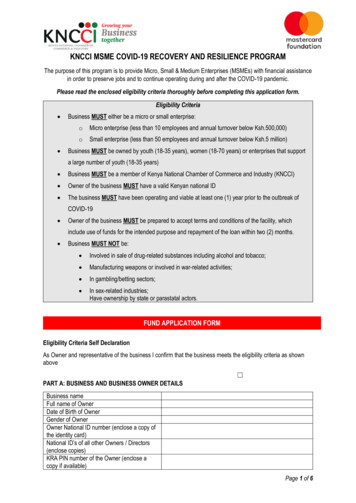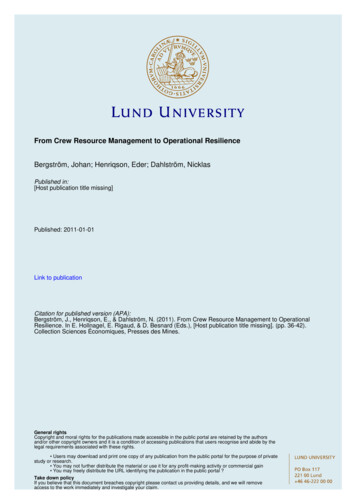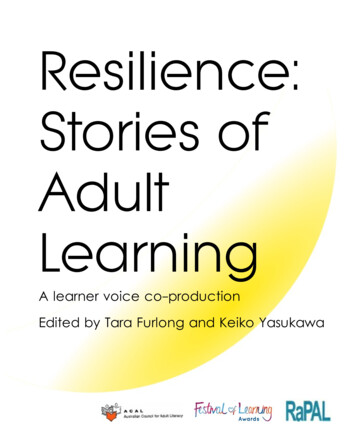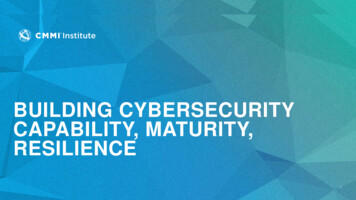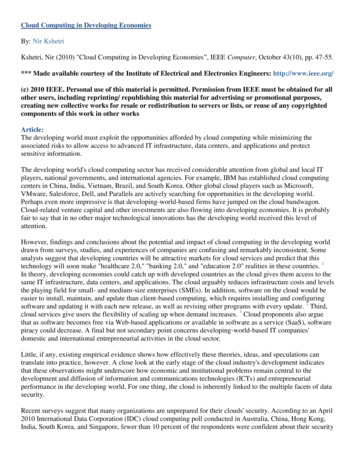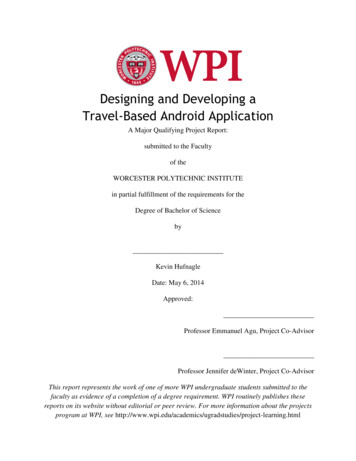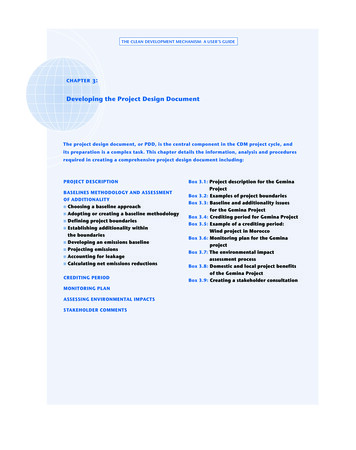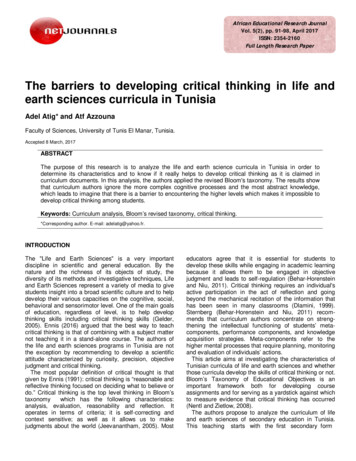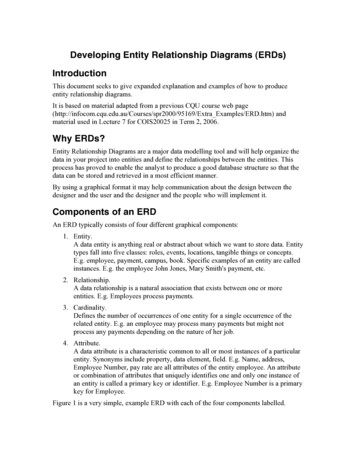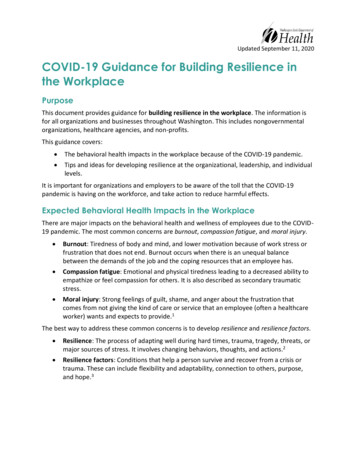
Transcription
Updated September 11, 2020COVID-19 Guidance for Building Resilience inthe WorkplacePurposeThis document provides guidance for building resilience in the workplace. The information isfor all organizations and businesses throughout Washington. This includes nongovernmentalorganizations, healthcare agencies, and non-profits.This guidance covers: The behavioral health impacts in the workplace because of the COVID-19 pandemic. Tips and ideas for developing resilience at the organizational, leadership, and individuallevels.It is important for organizations and employers to be aware of the toll that the COVID-19pandemic is having on the workforce, and take action to reduce harmful effects.Expected Behavioral Health Impacts in the WorkplaceThere are major impacts on the behavioral health and wellness of employees due to the COVID19 pandemic. The most common concerns are burnout, compassion fatigue, and moral injury. Burnout: Tiredness of body and mind, and lower motivation because of work stress orfrustration that does not end. Burnout occurs when there is an unequal balancebetween the demands of the job and the coping resources that an employee has. Compassion fatigue: Emotional and physical tiredness leading to a decreased ability toempathize or feel compassion for others. It is also described as secondary traumaticstress. Moral injury: Strong feelings of guilt, shame, and anger about the frustration thatcomes from not giving the kind of care or service that an employee (often a healthcareworker) wants and expects to provide.1The best way to address these common concerns is to develop resilience and resilience factors. Resilience: The process of adapting well during hard times, trauma, tragedy, threats, ormajor sources of stress. It involves changing behaviors, thoughts, and actions.2 Resilience factors: Conditions that help a person survive and recover from a crisis ortrauma. These can include flexibility and adaptability, connection to others, purpose,and hope.3
Increase Resilience to Support Your TeamsTo build resilience in the workplace, identify and put into practice the four resilience factors oringredients on both organizational and individual levels:1.2.3.4.Be able to adapt and be mentally flexible.Focus on developing social connections, both big and small.Develop a shared sense of purpose.Focus on hope.If your organization employs or supports those in higher risk occupations, such as healthcare,behavioral health, law enforcement, education, etc., see the COVID-19 Behavioral Health GroupImpact Reference Guide. This guide explains occupation-specific behavioral health concerns,risk factors, and support strategies.For more information about the phases of disaster, the behavioral health impacts related toeach phase, and information on additional groups, visit DOH's Behavioral Health Resources &Recommendations webpage.Organizational, Leadership, and Individual ResilienceOrganizational LevelOrganizational resilience depends on:4,5 Developing shared trust and interdependence among employers and employees.The organization’s ability to learn and adapt to lessons learned. Human Resources flexibility for work schedules and boundaries, time off, and job roles.Open, two-way communication among leadership and staff at all levels aboutexpectations and goals. 2
A resilient organizational culture: Supports flexibility and adaptability in a changing environment.Encourages setting healthy boundaries and models those healthy boundaries, whichmust start with leadership. Boundaries can include work time limits, job expectations,and job availability (i.e., being off work means not available for work activities).Prioritizes workforce wellness as a way to achieve the mission of the organization orcompany.Tips to increase organizational resilience: Keep workgroups or project teams together for the rest of the pandemic (or for as longas possible) to increase work connection for employees. Encourage and support work-life balance.*o Limit work hours to no more than 12 hours per day.o Limit work schedule to no more than two weeks without a break of at least 36 to48 hours.Develop work plans and set clear expectations about productivity given the problemscaused by the pandemic.6 *Develop communication guidelines that are responsive and clear.o Set boundaries around communication, noting the changes in workflow due toCOVID-19.6o Consider “offline” days that allow employees to work without having to beresponsive to digital communication.Rotate employees between high and low stress work or job tasks if possible. Encourage the use of the organizational Employee Assistance Program (EAP) whenavailable, as well as other outside support trainings or resources. Encourage employees to keep track of and talk about their exposure to very high stressevents when possible. Encourage employees to develop personal coping plans to follow during times of highstress. Develop clear definitions of roles because duties and workflows may have changed as aresult of the pandemic.6 When offering feedback, comment on positives before giving criticism.6 Encourage employees to stay in touch with their close social supports, such as familyand friends. Communicate the importance of having connection with others duringtimes of stress. Provide the opportunity for, but do not require, employees to share their experienceswith each other and with leadership throughout the balance-starts-with-managers3
Educate employees about the rise of substance use during the pandemic. Clearlycommunicate the preventative measures available in the workplace and the supportoffered through EAP when available.Keep track of the workplace for signs of harmful substance use. Refer to the tip sheetfor help identifying substance misuse from the Substance Abuse and Mental HealthServices Administration (SAMHSA).† Signs may include showing up at work with alcoholon breath or being impaired or hungover, or employee reports of increased drinking orcannabis use.o If substance use issues may be widespread in the workplace, think about doing aworkplace assessment for substance misuse problems.‡Leadership LevelLeadership resilience depends on: Understanding the many factors that add stress for yourself and your employees duringthis time. Creating a culture where people know that mistakes may lead to positive results.Understanding that everyone will make mistakes, and mistakes offer learningopportunities.6 Developing an awareness of behavioral and emotional reactions to stress and burnout.These can include emotional outbursts, having trouble concentrating, withdrawal fromothers, loss of interest in the job, and trouble completing tasks. Being aware that during a pandemic, there is pressure to get work done fast, beproductive, and available to do work. Understanding the need to create and sustain an environment where employeesknow they are valued, and they feel appreciated.Tips to increase resilience among leadership and supervisors:†‡ Create a system for recognizing employee efforts and accomplishments duringteam or one-on-one meetings. Promote fairness and work balance when giving out assignments, projects, and tasks,especially in higher stress roles. Make sure everyone understands their level of responsibility and authority in theorganization.6 Help create a team culture where it is okay to say “no” to requests that can’t be taken.Model this practice for your lace/toolkit/assess-workplace4
Encourage healthy work-life balance by modeling healthy boundaries around time spentworking and time off. For example, build breaks into your work schedule, remind teammembers to take breaks, and don’t do work tasks while off work.7,8,9,10,11,12,13 Model problem solving from a variety of viewpoints. Encourage team members to dothe same. Manage anger and reduce conflict between team members. Seek training on this forsupport or more information in this area. Provide the opportunity for, but do not require, team members to check in regularlywith their lead and colleagues to share how they are feeling about their work. One wayto do this is to have regular, short (e.g., 15 minute) team meetings for team members tocheck in on how they are feeling, report on what went well, share lessons learned, andsuggest changes.14,15 Share your own feelings and experiences as a leader. Watch employees for signs of too much stress. Warning signs may be physical andbehavioral, such as headaches, stomachaches, tiredness, irritability, and troublefocusing and finishing tasks. Secondhand or vicarious trauma occurs when exposure to high stress events creates apsychological trauma response, even when someone isn’t directly exposed to thetrauma. It can occur as a result of exposure to the experiences of others.o The signs of vicarious trauma may look the same as if being directly exposed, andcan be just as harmful.o Following the recommendations outlined throughout this document (seeindividual level tips in the next section) can help manage vicarious traumaexposure in yourself and team members. Create a culture of non-judgment. Set clear expectations that when someone appears tobe struggling, the organizational policy guides leadership and colleagues to reach out todiscuss and offer support. Clearly communicate a reporting tool for employees tofollow. Having concern while ignoring or not discussing the issue is unfair to theindividual and to the organization.11,13,16Keep track of employees for signs of harmful substance use. Refer to SAMHSA’s tipsheet for help identifying substance misuse. Signs may include showing up at work withalcohol on breath or being impaired or hungover, or employee reports of increaseddrinking or cannabis use. Individual LevelIndividual resilience depends on:1. Flexibility and Adaptability: Practice viewing changes as opportunities and challenges,rather than as threats. If you view something as a threat, even if it isn’t, you are morelikely to experience a sense of fear. Fear prevents us from challenging ourselves,enjoying new things, and growing.5
2. Purpose: Purpose comes from knowing your core values, such as honesty, gratitude,and courage, and working in a way that is consistent with them. Personal core valuesare different for everyone. No two people have the same sense of purpose based ontheir life experiences. Anything that motivates you is an example of something thatgives you purpose.3. Connection: Develop and keep connection by increasing the strength, quality, ornumber of healthy relationships in your life. A greater number of relationships isn’tnecessarily better. The quality of your connections is what makes the biggest difference.Friends, family, cultural and social groups, pets, and higher powers are all examples ofrelationships that increase your sense of connection and decrease feelings of isolationand loneliness. Connection is even more important during pandemics, and may requiregetting creative in how we build and keep our connections with others.4. Hope: Having a positive outlook is a powerful tool. Spend time thinking about all thepossible and likely outcomes of a situation, not just the negative things that mayhappen. It is okay to think about negative possibilities, but it is important to also giveattention to the positive possibilities. This practice increases hope.Tips to increase individual resilience: Define and work on developing your core values. Decide how you can live and workevery day in a way that is consistent with your best self, even if those steps are verysmall. Live in congruence. This means the ways in which you think, feel, and act agree withyour core values. Work on developing healthy boundaries.o This means taking responsibility for your own thoughts, feelings, and behaviors,and not blaming other people or a situation.o This also means not taking responsibility for other people’s thoughts, feelings,and behavior, and giving them the respect of allowing them to manage thosethings for themselves. Develop a self-care plan§ to follow when you are feeling high stress. Engage in self-carein order to reduce stress as soon as possible.REST Model to increase personal resilience:17It can be hard to do your job well and help others if your own need for rest is ignored. The RESTModel is a simple tool to help increase your resilience. This model helps support healthyboundaries and the development of resilience through purpose, connection, and lf-care-Plan.pdf6
REST ModelRewardReward yourself for a job well done. Build supports into your work. Forexample, give yourself a break from the patterns and issues you dealwith often. Take some time off or even just 15 minutes to dosomething you enjoy, such as watching a short video, going for a walk,or spending a few minutes doing a mindfulness exercise. Try to avoidrewards that include alcohol or drug use, as this can make job andpersonal stressors worse.Set or establish healthy boundaries. Focus on keeping work at workand leaving it there. When you are off work, stick to that boundary. Donot bring work into your personal time or space. For example, for thoseEstablish who are working at home, this may mean moving work materials intoanother room or space. Say “no” to a request that conflicts with yourboundaries, such as an expectation that you will answer work emailswhen off duty. Respectfully but firmly stick to set boundaries.ShareShare your feelings, concerns, and stories. Do not hold things in.Participate in support and professional consultation groups.Consultation groups can provide opportunities to talk about workmatters and offer social connection, which improves workplaceresilience. Do not avoid talking about things that bother you. Enjoy thesmall things in life by focusing on spending time with your family orsocial group. Make time for connections and activities in your life.TrustTrust your support network and reach out as needed. Refer peopleelsewhere if you are too tired or emotionally unable to offer support.Trust that others are willing to help. If the issues seem larger or moreserious, reach out for professional consultation and help. Keep areferral list of professional resources, such as your EAP and behavioralhealth professionals that you can go to when needed.Resilience Resources** SAMHSA:o Tip sheet for help identifying substance misuseo Assess your workplace for potential substance misuse issues Reach Out: Developing a self-care plan California State University: How to Create an Individualized Self-Care f-care-Plan.pdf7
University of Buffalo:o Self-care assessment††o Lifestyle behaviors checklist – Is your lifestyle causing you stress?‡‡o Maintenance self-care plan worksheet§§ Harvard Business Review: Developing better work-life balance articleAcknowledgementsThis document was developed by the Washington State Department of Health’s BehavioralHealth Strike Team for the COVID-19 response. It was written by Kira Mauseth, Ph.D, TonaMcGuire, Ph.D, and Matt Brickell, Psy.D., with support from a Seattle University studentresearch group.More COVID-19 Information and ResourcesStay up-to-date on the current COVID-19 situation in Washington, Governor Inslee’sproclamations, symptoms, how it spreads, and how and when people should get tested. Seeour Frequently Asked Questions for more information.A person’s race/ethnicity or nationality does not, itself, put them at greater risk of COVID-19.However, data are revealing that communities of color are being disproportionately impactedby COVID-19- this is due to the effects of racism, and in particular, structural racism, that leavessome groups with fewer opportunities to protect themselves and their communities. Stigmawill not help to fight the illness. Share accurate information with others to keep rumors andmisinformation from spreading. WA State Department of Health 2019 Novel Coronavirus Outbreak (COVID-19)WA State Coronavirus Response (COVID-19)Find Your Local Health Department or DistrictCDC Coronavirus (COVID-19)Stigma Reduction ResourcesHave more questions about COVID-19? Call our hotline: 1-800-525-0127, Monday – Friday, 6a.m. to 10 p.m., Weekends: 8 a.m. to 6 p.m. For interpretative services, press # when theyanswer and say your language. For questions about your own health, COVID-19 testing, ortesting results, please contact a health care provider.To request this document in another format, call 1-800-525-0127. Deaf or hard of hearingcustomers, please call 711 (Washington Relay) or email maintenance-self-careworksheet.pdf‡‡8
References1. Talbot, S. G., & Dean, W. (2018, July 26). Physicians aren't 'burning out.' They're suffering frommoral injury. STAT.2. Carver, C. S. (1998). Resilience and Thriving: Issues, Models, and Linkages. Journal of SocialIssues, 54(2), 245-266.3. Sarkar, M., & Fletcher, D. (2014). Ordinary Magic, Extraordinary Performance: PsychologicalResilience and Thriving in High Achievers. Sport, Exercise and Performance Psychology, 3(1), 46-60.4. Gittell, J. H., Cameron, K., Lim, S., & Rivas, V. (2006). Relationships, Layoffs, and OrganizationalResilience Airline Industry Responses to September 11. The Journal of Applied Behavioral Science,42(3), 300-324.5. Lengnick-Hall, C. A., Beck, T. E., & Lengnick-Hall, M. L. (2011). Developing a capacity fororganizational resilience through strategic human resource management. Human ResourceManagement Review, 21, 243-255.6. Jones, K., & Okun, T. (2001). White Supremacy Culture. In Dismantling Racism: A Workbook forSocial Change Groups.7. Figley, C. R. (2002). Compassion Fatigue: Psychotherapists' Chronic Lack of Self Care. Journal ofClinical Psychology, 58(11), 1433-1441.8. Herman, J. (1992). Trauma and Recovery. Basic Books.9. Hesse, A. R. (2002). Secondary trauma: How working with trauma survivors affects therapists.Clinical Social Work Journal, 30, 293-309.10. Joinson, C. (1992). Coping with compassion fatigue. Nursing, 22(4), 116-121.11. Phelps, A., Lloyd, D., Creamer, M., & Forbes, D. (2009). Caring for careers in the aftermath oftrauma. Journal of Aggression, Maltreatment and Trauma, 18, 313-330.12. Langelaan, S., Bakker, A. B., Schaufeli, W. B., Rhenen, W. Van, & Doornen, L. J. van. (2006). Doburned-out and work-engaged employees differ in the functioning of the hypothalamic-pituitaryadrenal axis? Scandinavian Journal of Work Environment Health, 32, 339-348.13. Pearlman, L. A., & Saakvitne, K. (1995). Trauma and the therapist: Countertransference and vicarioustraumatization in psychotherapy with incest survivors. W.W. Norton.14. SAMHSA. (n.d.). Understanding Compassion Fatigue. ing-Compassion-Fatigue/sma144869?referer from search result15. SAMHSA. (n.d.). First Responders and Disaster Responders Resource Portal. ders16. Harrison, R. L., & Westwood, M. J. (2009). Preventing vicarious traumatization of mental healththerapists: Identifying protective practices. Psychotherapy Theory, Research, Practice, Training, 46,203-219.17. Mauseth, K., Ph. D. (n.d.). REST Model. Health Support Team. http://healthsupportteam.org/9
Sep 11, 2020 · Prioritizes workforce wellness as a way to achieve the mission of the organization or company. Tips to increase organizational resilience: Keep workgroups or project teams together for the rest of the pandemic (or for as long as possible) to increase work connection
